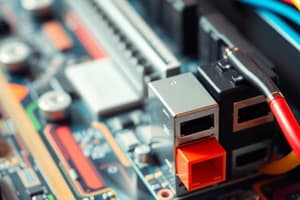Podcast
Questions and Answers
Explain the key difference between RAM and ROM in terms of their volatility and typical usage.
Explain the key difference between RAM and ROM in terms of their volatility and typical usage.
RAM is volatile memory used for currently running programs, while ROM is non-volatile memory that stores firmware or boot instructions.
What are the primary advantages of using an SSD over an HDD in a computer system?
What are the primary advantages of using an SSD over an HDD in a computer system?
SSDs offer faster data access speeds, lower latency, and greater durability compared to HDDs.
Describe the role of the motherboard in a computer, detailing at least three critical components it connects.
Describe the role of the motherboard in a computer, detailing at least three critical components it connects.
The motherboard acts as the central hub, connecting the CPU, RAM, and storage devices, facilitating communication between them.
Explain what is meant by 'plug and play' and how does the OS handle this?
Explain what is meant by 'plug and play' and how does the OS handle this?
Differentiate between application software and operating system software, providing one example of each.
Differentiate between application software and operating system software, providing one example of each.
Describe the role of device drivers in the interaction between the operating system and hardware components.
Describe the role of device drivers in the interaction between the operating system and hardware components.
A computer is running slowly, and the user notices the hard drive light is constantly on. What are two possible causes of this issue?
A computer is running slowly, and the user notices the hard drive light is constantly on. What are two possible causes of this issue?
Explain the purpose of expansion slots on a motherboard and provide two examples of common types of expansion cards that can be installed in these slots.
Explain the purpose of expansion slots on a motherboard and provide two examples of common types of expansion cards that can be installed in these slots.
A user installs new application software, but it fails to launch, displaying an error message related to missing system libraries. What is the likely problem?
A user installs new application software, but it fails to launch, displaying an error message related to missing system libraries. What is the likely problem?
Describe the function of the operating system in managing computer resources such as CPU time, memory, and storage.
Describe the function of the operating system in managing computer resources such as CPU time, memory, and storage.
Flashcards
Motherboard
Motherboard
The main circuit board containing the CPU, memory, and expansion slots; connects all parts of the computer.
RAM vs ROM
RAM vs ROM
RAM (Random Access Memory) is volatile, used for temporary data storage. ROM (Read-Only Memory) is non-volatile, storing permanent instructions.
SSD vs HDD
SSD vs HDD
SSD (Solid State Drive) uses flash memory for faster speed and durability. HDD (Hard Disk Drive) uses magnetic disks and is cheaper but slower.
Port on a motherboard
Port on a motherboard
Signup and view all the flashcards
Slots on a motherboard
Slots on a motherboard
Signup and view all the flashcards
Software
Software
Signup and view all the flashcards
Operating Systems
Operating Systems
Signup and view all the flashcards
Application software
Application software
Signup and view all the flashcards
Function of Operating System
Function of Operating System
Signup and view all the flashcards
Study Notes
Hardware
- Motherboard: Serves as the central hub for all computer components.
- RAM (Random Access Memory): Volatile memory used for short-term data storage, enabling quick access for active tasks.
- ROM (Read-Only Memory): Non-volatile memory that stores firmware and essential instructions for booting up the computer.
- SSD (Solid State Drive): Utilizes flash memory to store data, offering faster read and write speeds, lower latency, and greater durability compared to HDDs.
- HDD (Hard Disk Drive): Employs magnetic platters to store data, providing large storage capacities at a lower cost, but with slower performance and higher susceptibility to physical damage.
Ports on a Motherboard
- USB (Universal Serial Bus): Connects peripherals like keyboards, mice, and external storage devices.
- HDMI (High-Definition Multimedia Interface): Transmits high-quality video and audio signals to displays.
- Ethernet: Enables wired network connectivity for internet access and local network communication.
Slots on a Motherboard
- PCIe (Peripheral Component Interconnect Express): High-speed slots for expansion cards like GPUs, sound cards, and network cards.
- RAM Slots: Accommodate RAM modules, determining the system's memory capacity and performance.
Software
- Operating Systems (OS): Manages hardware and software resources, providing a platform for applications to run.
- Application Software: Programs designed for specific tasks, such as word processing, web browsing, and gaming.
Function of an Operating System
- Resource Management: Allocates and manages hardware resources like CPU time, memory, and storage.
- User Interface: Provides a way for users to interact with the computer, either through a graphical user interface (GUI) or command-line interface (CLI).
- Process Management: Controls the execution of programs, ensuring efficient multitasking and preventing conflicts.
- File Management: Organizes and stores files and directories, allowing users to easily access and manage their data.
Studying That Suits You
Use AI to generate personalized quizzes and flashcards to suit your learning preferences.
Description
Overview of essential computer hardware components including motherboard, RAM, ROM, SSD, and HDD. Explanation of ports on a motherboard, such as USB, HDMI, and Ethernet, detailing their functions.




